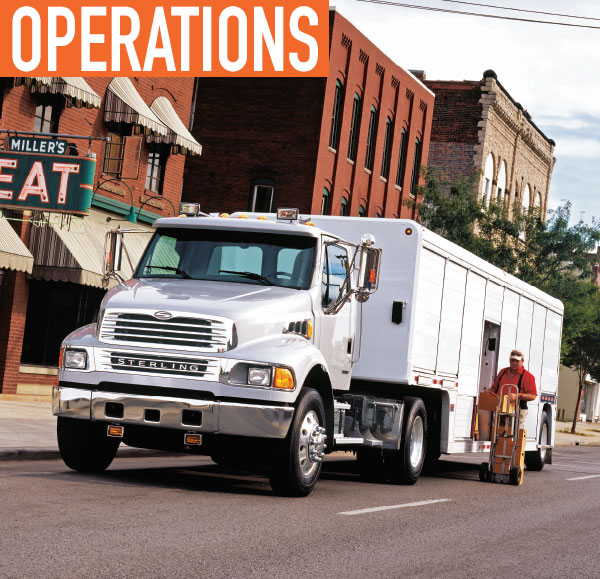We’ve all seen the headlines—internal combustion engines are all but on the way out, and electric vehicles, propane, natural gas, and hydrogen are ready to take over the fleet marketplace. But where does the truth lie? Just as new technologies promise the world, gas and diesel fuel aren’t standing still. They continue to get better. Here are five reasons why diesel continues to be a player:
1. Diesel is the gold standard in fleet operations because it is a proven technology with an unmatched combination of features. Thanks to its combination of features—fuel efficiency, power, performance, durability, reliability, ease of fueling, parts and maintenance, and now near-zero emissions, performance, durability, and efficiency—diesel remains the technology of choice for commercial vehicles around the world.
For the fleet manager, choosing diesel means working with an established and known quantity, a technology manufactured by trusted partners, OEMs, and dealers. Diesel technology is a proven performer that offers maximum flexibility in operations, extensive global fueling, and a parts and servicing network unmatched by any other technology. Add the technology’s new environmental and energy credentials, and diesel is easily part of a green and sustainable work truck fleet. Fleet managers can rest assured that diesel will be around for the foreseeable future. In fact, ExxonMobil estimates that diesel will replace gasoline as the number one global transport fuel by 2020.
Claims made by competing fuels and new manufacturers can be hard to sort out. Without extensive and relevant commercial testing and experience, the full range of operational, short-term, and long-term considerations may not be clear. Comparisons to conventional fuels are often based on small sample sizes of in-trial and under-development fleets, not on actual revenue service.
On top of that, the total cost of ownership for new technologies is often obscured by incentives or enticements from the manufacturer, governments, or utilities who buy-down the difference in initial vehicle investments and/or offer special pricing agreements for fuel or infrastructure, making precise apples-to-apples comparisons with existing diesel or gasoline technologies difficult to make.
With no repair history or service experience from new fuels or market entrants, fleets will have a difficult time comparing those key business performance indicators with years of extensive data based on gas and diesel fleets. This is not to dismiss the potential benefits and opportunity that some of the new fuels may bring to some fleets, but every fleet manager must evaluate those opportunities on their terms.
2. Investing in new-technology diesel engines helps clean the air. Over the last 15 years, truck and engine makers have worked to virtually eliminate emissions from diesel engines of all sizes. The national transition to ultra-low-sulfur diesel fuel in 2006 coupled with advancements in engine combustion, turbocharging, and high-pressure fuel injection played a major role in improving diesel’s environmental outlook. Adding today’s advanced emissions controls, such as selective catalytic reduction (SCR) and particulate filters, enables the newest generation of diesel engines to achieve near-zero levels of emissions of both particulates and nitrogen oxides.
Just how clean are today’s diesel engines? According to a study done in 2012 by researchers at the University of California Riverside, charbroiling a 1/3 lb hamburger on an open flame generates more particulate matter (PM) emissions than driving 143 miles in a new heavy-duty diesel commercial truck.
3. Investing in new-technology diesel engines helps lower GHG emissions. As more new-technology diesels operate on the roads and jobsites, real societal benefits are accruing. These include thousands of dollars in fuel-cost savings and reduced greenhouse gas (GHG) emissions.
Consider that the 3.6 million heavy-duty diesel trucks (Class 3-8) introduced from 2011 through 2017 saved the American consumer 59 million tonnes of carbon dioxide (CO2); 5.8 billion gallons of diesel; 138 million barrels of crude oil; not to mention 26 million tonnes of nitrogen oxides (NOx) and 1.5 million tonnes of PM.
These reductions are equivalent to removing the CO2 emissions from all cars on the road for four years.
4. Fleets are investing in more diesel, not less. Diesel remains the technology of choice for more than 97% of all heavy-duty commercial trucks today. In 2017, 36% of Class 3-8 commercial vehicles on America’s roads used the newest generation of near-zero emissions diesel engines.
Even with substantial incentives offered by alternative fuels and other programs, alternative fuels like natural gas and propane remain “niche” fuels in the work truck segment. For example: nationwide, natural gas remains at just 4% of all commercial vehicles. This is true even in states like California, which institutes many policies and invests hundreds of millions of dollars in alternative fuels and infrastructure.
Meanwhile since 2015, about 700,000 new-technology diesel commercial vehicles have been put into service, delivering more fuel savings and clean air benefits.
5. Diesel is continually improving. Just as truck and engine makers continue to explore electric and other alternative fuel powertrains, they continue to invest in optimizing diesel engine efficiency, performance, and emissions reduction. Diesel continues to dominate and compete at the very highest levels by continuous improvement of the core technology, further progress toward nearer-to-zero NOx emissions, integration into hybrid powertrains, and the expanding use of advanced renewable biodiesel fuels, particularly in urban areas.
Advancements in transmissions, turbocharging, and fuel injection enabled the downsizing of engines without a loss in performance. Smaller engines consume less fuel and weigh less, allowing vehicles to take on more payload while lowering the cost and complexity of emissions control systems. New research into renewable diesel fuels and biodiesel give tomorrow’s diesel engines an even better environmental outlook. Most of today’s diesel engines—of any size, in any application—can run on high-quality blends of biodiesel with little modification or use drop-in renewable diesel fuels. These non-petroleum-based diesel fuels can reduce greenhouse gas emissions by at least 50%.
While today’s new-technology diesel engines are near zero emissions, engine and truck manufacturers are in active discussions with California and the US Environmental Protection Agency about the next step for taking diesel engines even closer to zero emissions.
PARTING THOUGHT
The future requires many solutions. Diesel is one of them. Meeting the many societal challenges of the future requires many technologies. Technologies meeting the needs of the work truck fleets of today or tomorrow must operate in that same world. There is not a single, perfect, one-size-fits-all work truck fuel or powertrain. But, even as work truck fleet managers evaluate up-and-coming technologies, they’d be smart to continue to invest in the new generation of diesel, a proven performer that gets the job done every day.
FOR MORE INFORMATION
Allen Schaeffer is the executive director of the Diesel Technology Forum, a non-profit organization dedicated to raising awareness about the importance of diesel engines, fuel, and technology. He holds a Masters in Environmental Health Sciences from the Johns Hopkins University Bloomberg School of Public Health and a Bachelor of Science from the University of Maryland. Find out more, visit www.dieselforum.org.
MODERN WORKTRUCK SOLUTIONS: SEPTEMBER 2018 ISSUE
Did you enjoy this article?
Subscribe to the FREE Digital Edition of Modern WorkTruck Solutions magazine.
![]()





